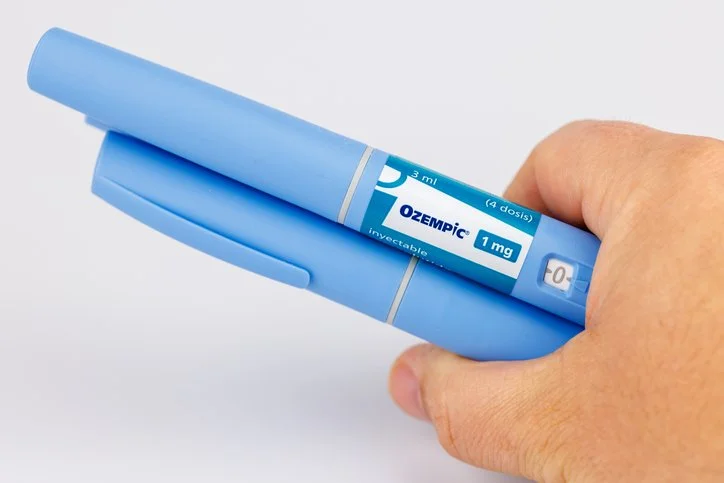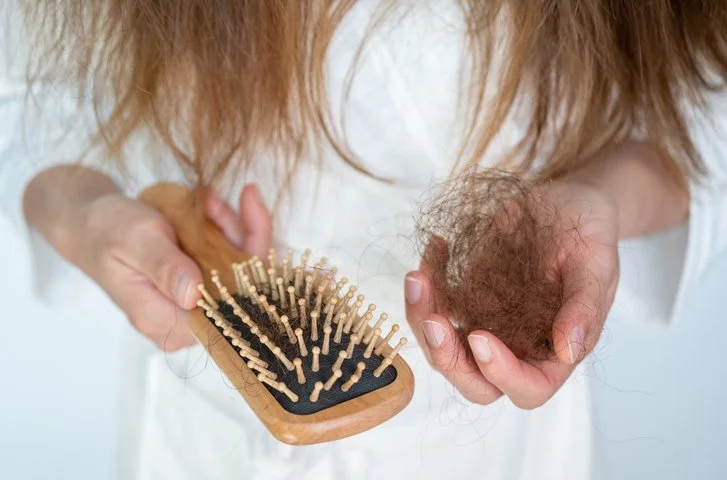Ozempic (Semaglutide) & Nutrient Deficits—3 Real-Life Warnings
By: Joy Stephenson-Laws, Holistic Coach, J.D., Founder
The Morning Scroll That Sparked a Deep Dive
The statistic landed in my pre-matcha brain like a cymbal crash: in 2021, U.S. doctors wrote 8.2 million prescriptions for semaglutide, and nearly two million people were already taking the drug—three-times the head-count just two years earlier (Pew Research Center).
That morning scroll sent me down a rabbit hole of real-life stories. Each began with the same silver-blue Ozempic® pen, yet each detoured into a lesson about nutrients, appetite and the price of rapid progress the way a campfire tale suddenly warns of the dark.
Story 1: Claudia’s Cinematic Weight-Loss … and the Hair-Brush Horror
Claudia Oshry—Instagram’s irreverent “Girl With No Job”—mentioned Ozempic almost casually on her podcast The Toast. By Halloween 2023, she was buying smaller jeans and quipping that the pounds “melted like a time-lapse.” All told, 70 pounds vanished in a single season.
Then came the sound no influencer wants: the shower drain gurgling as fistfuls of hair slipped away. In a candid Instagram Q&A, Claudia admitted the shedding lasted “six to nine months” even after she quit the drug. Only a full-court press—Nutrafol supplements, prenatal vitamins, topical minoxidil, and a protein-packed diet—coaxed her ponytail back (people.com).
Why did her mane revolt?
Hair is built from keratin, a protein that demands iron, zinc, biotin, and total calories to synthesize. Chop daily intake in half and follicles panic; they leap out of the growth phase long before belly fat budges. The lesson Claudia now posts on reels: “Fast weight loss can silence hunger, but it also starves your most delicate tissues first.”
Story 2: Lottie’s Shortcut to the ER
Twenty-six-year-old model Lottie Moss—half-sister of fashion icon Kate Moss—was tired of waiting on Pilates to sculpt her waist, so she snagged a black-market Ozempic dosage formulated for someone twice her weight. The appetite suppression was instant; the nausea followed close behind.
By day 14 she couldn’t keep water down. At 3 a.m. she staggered into A&E dehydrated, vomiting, and convulsing in a full-blown seizure. The ER nurse’s verdict was stark: “You’re taking a dose meant for a 220-pound patient. Severe dehydration plus electrolyte collapse triggered the seizure.” (people.com).
Semaglutide slows stomach emptying—great for steady blood sugar, brutal for fluid intake. Strip away sodium, potassium, and magnesium and the body’s electrical grid shorts out. On her Dream On podcast, Lottie now calls the experiment “the worst decision I ever made,” urging followers to hydrate like it’s a second job and to feed their bodies before, during, and after any weight-loss therapy.
Story 3: Zee’s Plateau—and the Dietitian Who Turned the Tide
Good Housekeeping journalist Zee Krstic began Ozempic to tame a runaway A1C after long-COVID pushed him into type-2 diabetes. The scale rewarded him: 64 pounds down. Then progress froze, replaced by led-blanket fatigue. Lab work told the story: sagging protein markers and early muscle loss.
Enter a registered dietitian wielding Mediterranean wisdom. Out went lazy keto; in came salmon drizzled in olive oil, lentil soups, and rainbow salads with feta and walnuts. Twice a week, Zee swapped endless cardio for resistance circuits—rows, deadlifts, band presses. Within a month, energy returned, muscle tone re-emerged, and the weight-loss plateau cracked. His takeaway is taped to his fridge: “Ozempic can mute hunger, but only balanced meals and strength work rebuild the machinery that burns calories.” (Good Housekeeping).
The Common Thread: Hidden Hunger
Claudia lost hair, Lottie lost consciousness, Zee nearly lost muscle—but all three brushed up against the same invisible wall: nutrient deficiency. Even before Ozempic became a cultural phenomenon, America was already under-fed at the micronutrient level.
95 percent of U.S. adults fail to meet daily fiber goals, one reason gut microbes and blood sugar misbehave (Vox).
Global reviews peg roughly 2 billion people as deficient in key vitamins or minerals—a “silent epidemic” the World Health Organization calls hidden hunger. (BioMed Central).
Shrink overall food intake with a GLP-1 drug and small nutrient gaps widen into canyons. Hair follicles, heart cells, and neurons all depend on minerals long before fat cells finish yielding stored energy.
Why Semaglutide Magnifies Deficiency Risk
Delayed gastric emptying. Food lingers in the stomach, so fewer meals feel necessary.
Nausea, vomiting, or diarrhea. GI distress lowers nutrient absorption and discourages eating.
Appetite-signal silencing. Hunger hormones plunge, making it easy to skip nutrient-dense meals.
Rapid caloric deficit. When losses exceed 1–2 pounds per week, muscle breakdown and micronutrient depletion accelerate.
Think of semaglutide as turning down the “fuel gauge” light; you’ll stop at the gas station less often. If you don’t deliberately fill up on premium fuel—protein, vitamins, minerals—your engine will sputter.
Reconstructing Health: A Step-by-Step Roadmap
Step 1: Baseline Labs Before the First Injection
Request a panel that covers CBC, ferritin, B-12, folate, vitamin D, magnesium, iron, calcium, and thyroid. Repeat every three to six months.
Step 2: Protein + Color at Every Meal
Aim for 1 gram of protein per kilogram of goal body weight. Pair each serving with two fist-sized heaps of produce. Even if appetite is tiny, “every bite must carry a payload”—Claudia’s words, not mine.
Step 3: Fiber as Your Gut Insurance Policy
Blend chia seeds into yogurt, swap white rice for lentils, add raspberries to oats. Fiber tames constipation (a common Ozempic side-effect) and feeds gut microbes that help regulate weight.
Step 4: Hydration With Electrolytes
Copy Lottie’s post-ER rule: One glass of water for every waking hour on injection days, plus a pinch of sea salt or a magnesium-potassium tablet.
Step 5: Resistance Beats Cardio for Muscle Preservation
Follow Zee’s two-day split: upper-body push/pull on Tuesday, lower-body hinges and squats on Friday. Muscle mass protects metabolism, glucose disposal, and bone density.
Step 6: Surgical Supplementation
Meet deficiencies with targeted doses—iron only if ferritin is low, vitamin D only if below 30 ng/mL. Blind megadoses can backfire.
Step 7: Journal the Whispers
Note energy levels, hair shedding, skin changes, menstrual irregularities, or brain fog. Early whispers avert loud warnings.
Bridging the Gap With Food—A Day in the Life
Breakfast (post-shot, low appetite)
6 oz Greek yogurt (17 g protein)
1 tbsp chia seeds (fiber & omega-3)
½ cup blueberries (antioxidants, manganese)
Mid-morning Electrolyte
12 oz water with unsweetened coconut water splash and magnesium powder
Lunch
Lentil-quinoa pilaf tossed with roasted veggies, olive oil, and feta (25 g protein, fiber, folate, magnesium)
Dinner
4 oz grilled salmon (25 g protein, omega-3, vitamin D)
1 cup sautéed spinach with garlic (iron, vitamin K, magnesium)
Small baked sweet potato (beta-carotene, potassium)
Before Bed
Prenatal multivitamin (Claudia’s hair-recovery secret weapon)
8 oz water
Over 1,300 nutrient-dense calories—enough to keep fat loss steady without robbing the vault.
The Bigger Conversation: Rethinking the “Goal Weight”
Ozempic can be life-changing for type-2 diabetes, PCOS, and obesity. But numbers can hypnotize us, making the scale’s downward tick feel like the only scoreboard. Claudia’s mirror, Lottie’s hospital bracelet, Zee’s gym log—they all reveal a broader metric: vitality.
Can you chase your toddler without wheezing?
Does your hair shine and your skin heal quickly?
Is your mood steady, your sleep restorative, your heartbeat calm after three flights of stairs?
Those signals come from nutrients, hydration, and muscle before they ever come from a needle.
When to Call the Doctor—Red-Flag Symptoms
Persistent nausea > 48 hrs
Inability to keep fluids down
Hair shedding that lasts > 3 weeks
Muscle cramps or restless legs
Extreme fatigue or brain fog
Don’t wait for things to “settle.” Hidden hunger escalates silently until, like Lottie, you’re staring at fluorescent lights.
Conclusion: Turning Cautionary Tales Into Empowered Journeys
Three people, three detours:
Claudia lost nutrients faster than pounds—until protein and iron rebuilt her roots.
Lottie learned that water, salt, and dosage wisdom are non-negotiable.
Zee discovered a dietitian and a barbell could restart stalled progress.
Their stories transform Pew’s shocking statistics into a human map. If Ozempic—or any GLP-1 drug—plays a role in your life, let it ride shotgun. You steer with labs, color-rich meals, electrolytes, and muscle-building movement.
Because the real victory isn’t a lower number; it’s more life in every heartbeat, strand of hair, and morning after you step off the scale.
(Scientific Support — Why These Stories Aren’t Just Anecdotes
Two recent peer-reviewed studies confirm the exact risks Claudia, Lottie, and Zee encountered:
Lean-mass loss is real.
A 2024 systematic review in Expert Opinion on Pharmacotherapy evaluated six randomized trials (1,541 adults) and found that while semaglutide preferentially reduced fat, up to 40 % of the pounds lost came from muscle and other lean tissue. The reviewers warn that “clinically meaningful losses of lean mass” become more pronounced the longer and larger the study. (PubMed).Micronutrient intake falls below recommended levels.
In a 2025 cross-sectional study published in Frontiers in Nutrition, researchers compared food logs from 69 long-term GLP-1 users with Dietary Reference Intakes. They discovered consistent shortfalls in fiber, calcium, iron, magnesium, potassium, choline, and vitamins A, C, D, and E—and noted that protein, though adequate as a percent of calories, was insufficient per body-weight needs for preserving lean mass. The authors conclude that patient-specific nutrition guidance is “essential to prevent unintended health consequences” during GLP-1 therapy. (PubMed).
Taken together, these data reinforce the core message of this blog: semaglutide can mute hunger and shrink the scale, but without deliberate protein, micronutrients, hydration, and resistance training, you risk trading fat for muscle and vitality.
(Always consult your healthcare provider for individualized advice.)






